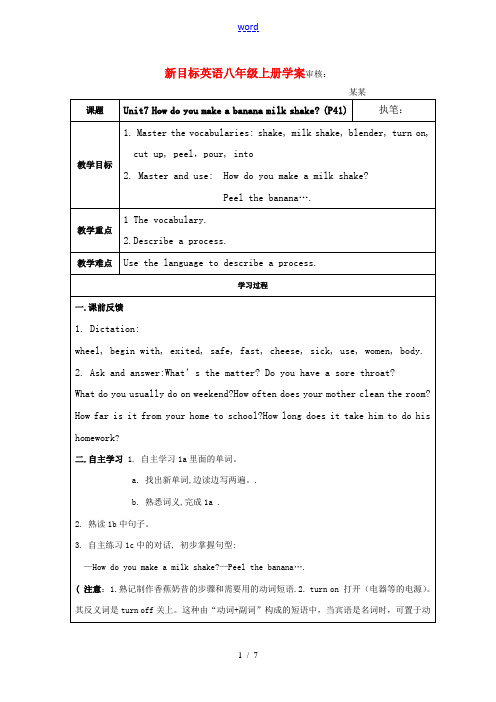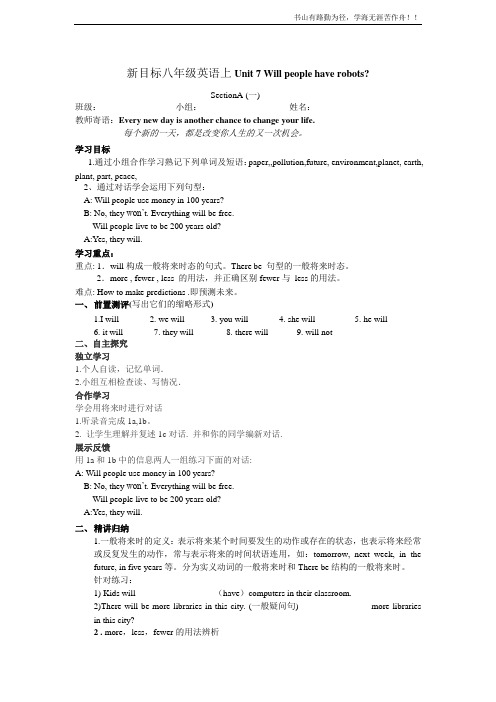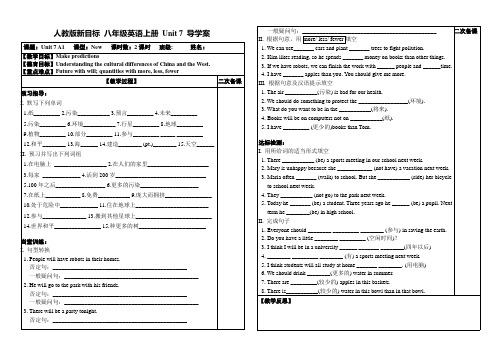新目标八上unit 7学案
人教版新目标八年级上册英语 Unit 7 单元导学案

执笔审核课型课时授课班级148149授课时间姓名学案编号No.3【课题】Unit 7 Will people have robots?Period 3 Section A 2d教师复备栏或学生笔记栏【学习目标】1.熟练掌握词汇:future,environment,planet,building,play a part,world peace2. 熟练掌握以下句型(1)In the future,there will be...(2)A:Will there be... ?B:Yes,I hope so.【学习重点难点】1. 学会运用there be句型的一般将来时和will 构成的一般将来时态对未来进行预测。
2. 学会运用“more, fewer, less”比较多少【学法指导】预习单词、短语----听后跟读----朗读-----写作模仿【教学过程】一、导入(启发探究3分钟).根据实际情况,回答下列问题:1. Which school are you in now? _____________________________________2. What do you think the school will be like in the future? ____________________3. What’s the city like now?__________________________________________4. What do you think the city be like in the future? ________________________二、自学(自主探究6分钟)2d学习.(1)Read the conversation quickly and answer a question.What is the book that Jill is reading about?(2) Read it carefully and judge the sentences are right or wrong. (R or W)A. Cities will not be crowded and polluted any more in the future.B. There will be a lo t of trees everywhere and the environment will be beautiful.C. People will use less water and plant more trees to save the earth in the future.(3) Listen and repeat. The read aloud for 5 minutes to recite(4)Role-play the conversation.语言点:1.about. prep.关于It’s a book ____________the f uture .这是一本关于未来的书2.move to 搬到.. We have to_______________ other city.3.play a part in (doing)sth. 参与,在..中扮演角色,起作用.Everyone should play a part in__________________(save)the earth.例2.There __ a basketball match tomorrow.A. will haveB. haveC. hasD.will be例3,--Why are you in such a hurry,Mike?---There ___an NBA basketball game in ten minutes.A.will haveB. will beC.is going to haveD. are going to be例句4.There____ an interesting cartoon on CCT-6 at 7:30 this evening.A.is going to haveB. is going to beC. will haveD.will to be五、练评(包含“考点链接” 应用探究6分钟)1.Everything ___ ok.A.areB. isC. wereD.was2.There is ___ with my watch.A. something wrongB.wrong somethingC.anything wrongD.wrong anything3.Would you like to pass me___ paper?(多)A.aB. a piece ofC.two piece ofD. two pieces of4.The English teacher is handing out the__ to students.A.PaperB.a piece of paperC. pieces of paperD. pap5.At first, there is ___ water in the cup, after drinking, there is __ water in the cup.A.fewB.a fewC.littleD.a littleⅠ. 用所给单词的适当形式填空。
人教新目标八年级英语上册教案Unit 7 Section A

Unit 7 Will people have robots?Section A教学设计Period 1 1a-1c教材分析本节课是一节听说课。
首先通过机器人的图片设置问题Do people have robots now?和Will people have robots in their homes in 50 years? 引起学生对现在和未来的思考,从而导入新课并输入目标语言。
因为本单元是学生学习一般将来时( will)的重要组成部分,一开始应该尽量让学生接触丰富的语言材料,感知、体会目标语言的运用,并进行模仿性输出。
教学目标1.学生能学会重点词汇以及目标语言。
2.熟练运用目标语言谈论未来的世界。
3.在听的过程中体验感知目标语言在真实语境中的应用,并学会提取关键信息。
教学重难点重点:future, environment, building难点:1 -Will people use money in 100 years?-No, they won’t. Everything will be free2. There will be (more/less/fewer) free time.3. more, fewer, less表示数量的用法课前准备让学生课前通过各种信息源了解人们对于未来世界和生活的各种预测。
准备好录音机,制作多媒体课件及学案。
教学过程Step 1: Lead-inAsk students: Do people have robots now?Students would probably say that robots are working in factories.【设计意图】把学生引入一般现在时态的情境,也为下一步进入一般将来时态并谈论将来作好铺垫,同时也能给学生较强的时态对比感。
Step 2: PresentationAsk students two questions:1. Will people have robots in their homes in 50 years?2.Will people have robots in their homes 100 years from now?【设计意图】在未来,机器人能否走进我们的家庭生活,问题贴近学生的生活实际,让学生有表达的欲望,有话可说并自然而然地接触到一般将来时态。
八年级英语上册 unit7学案 人教新目标版

How far is it from your home to school?How long does it take him to do his homework?
学习过程
一.课前反馈
1. Dictation:
wheel, begin with, exited, safe, fast, cheese, sick, use, women, body.
2. Ask and answer:What’s the matter? Do you have a sore throat?
Follow instructions.
3.Listening skills.
教学难点
Listening skills.
学习过程
一.课前反馈
1.Dictation: ingredient, cup, watermelom, teaspoon, amount, instruction, finally, mix up, popcorn, popper, boil, salt, add to,
六.新知提示预习Unit 8的单词。
2. Master and use: Countable nouns and uncountable nouns.
Follow instructions.
教学重点
1 The vocabulary.
2. Master and use: Countable nouns and uncountable nouns.
三.合作探究
1.小组讨论并检查1a的答案。
八年级英语上册Unit7 教案新版人教新目标版

自主学习方案1.自学生词,并记住拼读及拼写。
2.预习课本,找出重点短语和句子。
(见学案自学导练内容)3.读记后完成自学导练内容。
课堂导学方案Step 1 情景导入(1分钟)教师通过播放一段机器人帮助人类做事的录像,导入本节课的话题。
T:What’s in the video?S: It is a robot.T: Do you think there will be robots in people’s homes?S: Yes, there will./No, there won’t.T: In the future, great changes will take place. What do you think the futurewill be like? (老师提示用will作答)S:(学生各抒己见)I think there will only be one country. There will no paper money. People will live to be 200 years old…教师要求学生根据自己的想法,对1a作出自己的判断。
环节说明:通过播放录像导入话题,学生的兴趣比较浓厚,告知学生本单元的语言目标,学生学习起来能够做到心中有数,可以更好地帮助学生学习新课。
Step 2 完成教材1a—1c的任务1.熟读1a中的句子,并两人一组互相背诵句子。
(5分钟)2.以小组为单位,结合图片和1a中的句子,小组讨论一般将来时态的各种句型的构成,教师点拨。
(5分钟)3.认真听录音,并在1a中圈出你所听到的预测,集体核对答案,完成课本上1b的听力任务。
(3分钟)4.再听一遍录音,并跟读对话。
(2分钟)5.仿照1c中的对话,两人一组对1a中的活动进行对话练习,并邀请一些小组表演对话。
(5分钟)6.小结练习。
(3分钟)( B )(1)I hear he will be back _________two days.A. atB. inC. afterD. for(2)There will be (be) a talk show on CCTV-2 at eight this evening.(3)There is (be) some paper on the table.(4)I often listen to music on (介词) the radio.环节说明:听说结合,第一时间向学生传达语言目标。
新目标英语八年级上册第Unit7 SectionA导学案

新目标8年级上册第7单元Section A预习导纲up仔细观察下面例句中up义和用法,然后补全结论部分所缺的内容。
.up1)-Why are you cutting up the tomatoes, mum?-Because we are making tomato and beef noodles for us..2)Please hands up if you would like to go on vacation next week.3)We drank up the milk at home, let me go out to buy some.4)Mrs Green gets up very early every morning to make breakfast for her daughter【结论】根据以上例句可知up是一个副词,意思比较多:○1(1)___________;○2(2)____________;○3(3)_____________;○4(4)___________关于up的短语有:cut up(5)________ mix up(6)_________get up(7)________stay up(8)_______stand up(9)________hands up(10)__________eat up(11)_________ turn up(12)________1.分开;成几部分2.完全的,彻底的,尽了,完了3.从下往上地,向上地4. 起床,未睡5.切碎6.混合起来7.起床8.熬夜9.起立10.举手11.吃完12.把音量调高【运用】将下列汉语句子翻译成英语1.今天天气很热,让我们切一个西瓜吃吧。
It’s hot today, let’s_________ _________a watermelon to eat.2.你把这些香蕉和苹果切碎然后混合起来。
人教版新目标八年级上课件、教案Unit7初二英语unit7导学案

新目标八年级英语上Unit 7 Will people have robots?SectionA (一)班级:________________ 小组:___________________ 姓名:____________________教师寄语:Every new day is another chance to change your life.每个新的一天,都是改变你人生的又一次机会。
学习目标1.通过小组合作学习熟记下列单词及短语:paper,,pollution,future, environment,planet, earth, plant, part, peace,2、通过对话学会运用下列句型:A: Will people use money in 100 years?B: No, they won’t. Everything will be free.Will people live to be 200 years old?A:Yes, they will.学习重点:重点:1.will构成一般将来时态的句式。
There be 句型的一般将来时态。
2.more , fewer , less 的用法,并正确区别fewer与less的用法。
难点: How to make predictions .即预测未来。
一、前置测评(写出它们的缩略形式)1.I will ______2. we will _____3. you will ______4. she will ________5. he will ______6. it will ______7. they will _______8. there will ______9. will not ______二、自主探究独立学习1.个人自读,记忆单词.2.小组互相检查读、写情况.合作学习学会用将来时进行对话1.听录音完成1a,1b。
2. 让学生理解并复述1c对话. 并和你的同学编新对话.展示反馈用1a和1b中的信息两人一组练习下面的对话:A: Will people use money in 100 years?B: No, they won’t. Everything will be free.Will people live to be 200 years old?A:Yes, they will.二、精讲归纳1.一般将来时的定义:表示将来某个时间要发生的动作或存在的状态,也表示将来经常或反复发生的动作,常与表示将来的时间状语连用,如:tomorrow, next week, in the future, in five years等。
人教版新目标八年级英语上册 Unit 7 导学案

人教版新目标八年级英语上册Unit 7 导学案课题:Unit 7 A1 课型:New 课时数:2课时班级: 姓名:【教学目标】Make predictions【德育目标】Understanding the cultural differences of China and the West.【重点难点】Future with will; quantities with more, less, fewer【教学过程】二次备课预习指导:I. 默写下列单词1.纸_________2.污染___________3.预言_________4.未来_________5.污染_________6.环境___________7.行星_________8.地球_________9.植物_________ 10.部分_________ 11.参与_________ _____ _________12.和平________ 13.海______ 14.建造________ (pt.)________ 15.天空______II. 预习并写出下列词组1.在电脑上__________________2.在人们的家里_____________________3.每家_____________4.活到200岁_______________________________5.100年之后_________________6.更多的污染____________________7.在纸上____________ 8.免费___________ 9.庞大而拥挤________________10.处于危险中_____________ 11.住在地球上_________________________12.参与_______________ 13.搬到其他星球上__________________________14.世界和平________________ 15.种更多的树_______________________当堂训练:I. 句型转换1. People will have robots in their homes.否定句:______________________________________________一般疑问句:______________________________________________2. He will go to the park with his friends.否定句:______________________________________________一般疑问句:______________________________________________3. There will be a party tonight.否定句:______________________________________________人教版新目标八年级英语上册Unit 7 导学案课题:Unit 7 A2 课型:New 课时数:2课时班级: 姓名:【教学目标】Make predictions【德育目标】Understanding the cultural differences of China and the West.【重点难点】Future with will; quantities with more, less, fewer【教学过程】二次备课预习指导:I. 背Grammar focus 并写出下列句子1.城市将会是什么样子?城市将受到更多污染并且有更少的树。
人教新目标八年级英语上册第7单元教案(教学设计)

单元 课时 安排
Period 1 Period 2 Period 3 Period 4 Period 5-6 Period 7 Period 8
section A 1a—1c section A 2a-2d section A Grammer Focus-3c section B 1a-1e section B 2a-2e section B 3a-3c section B 4-self check
Teaching Notes
Reflection after teaching
签批
2
Unit 7
Period2
Section A (2a-2d ) 总课时 48
Teaching Aims
Teaching Key Points Teaching Difficult Points Teaching Methods
做预言,用 will 来讨论未来发生的事情
Teaching Methods Audio-lingual method; Communicative Approach; PPT
Teaching Procedures
Step 1 情景导入 (Show a picture of a robot) Teacher:What's this? Students:It's a robot. Step 2 完成教材 1a—1c 的任务 1.在今后的 100 年里世界将会有怎样的不同呢?阅读 1a 中的预言,同意请在 A 处打勾,不同意请在 D 处打勾,完成后小组内互相交流。(3 分钟) 2.熟读 1a 中的句子,并两人一组互相背诵句子。(5 分钟) 3.以小组为单位,结合图片和 1a 中的句子,小组讨论一般将来时态的各种句型 的构成,教师点拨。(5 分钟) 1.will 表示将来时的用法 1)他们将有个愉快的寒假。 They_will_have_a_pleasant_winter_holiday. 2)他们将不会有一个愉快的寒假。 They_won't_have_a_pleasant_winter_holiday. 3)他们将有个愉快的寒假吗?是的,会有。/不,不会的。 Will_they_have_a_pleasant_winter_holiday ? Yes , they_will./No , they_won't. 一般将来时态表达将来某一时间要发生或将要发生的动作或状态。其陈述句构成 为:主语+will+动词原形(当主语为第一人称时,一般用 shall 代替 will;当主语 为其他人称时,用 will,但主语为第一人称时,也可以用 will)。 否定句:主语+will+not+动词原形. 一般疑问句:Will+主语+动词原形? 肯定回答:Yes,主+will. 否定回答:No,主+will+not(可以缩写成 won't). 2.in+一段时间的用法 1)他三个小时以后回来。 He'll_come_back_in_three_hours. “ in + 一 段 时 间 ” 表 示时 间 段 之 后 , 常 用 于 将来 时 态 中 。 对 此 短 语 提问 用 How_soon。
- 1、下载文档前请自行甄别文档内容的完整性,平台不提供额外的编辑、内容补充、找答案等附加服务。
- 2、"仅部分预览"的文档,不可在线预览部分如存在完整性等问题,可反馈申请退款(可完整预览的文档不适用该条件!)。
- 3、如文档侵犯您的权益,请联系客服反馈,我们会尽快为您处理(人工客服工作时间:9:00-18:30)。
Unit 7 How do you make a banana milk shake?Period 1一、学习内容:Section A (1a-Grammar)二、学习目标 1. 学完Section A部分单词.2. 完成Section A 包括听力在内的大部分内容。
三、学习重点:描述制作奶昔的过程.四、学习难点;描述制作奶昔的过程.五、导与学过程环节一:引入目标,内容概述T: Do you like drinking milk shake? How do you make a banana milk shake?S: Yes, we all like it very much.How do you make …? (板书)make的几种用法: make a car, make the bed, make a plan for, make faces, make sb. laugh, make sb. angry, make money, make a mistake...环节二:自主学习,合作探究1.单词词组的自主学习1)打开(电器)____________ 它的反义词组是___________2)写出以下短语切碎把……倒进……. 把……放进3)how many 修饰_________;how much修饰______________,它还可以以用来询问_________。
制作奶昔需要用到的的六个词组:1)2)3)4)5)6)3. 按顺序写出制作奶昔的六个步骤:4. 句型的自主学习:(见教材Grammar focus)How many+可数名词复数+do we need?How much+不可数名词复数+do we need?5. 听力训练1b, 2a &2b.环节三:展示交流,点拨释疑1. Pairwork A: How do you make a banana milk shake?B: Peel the bananas… (1b)2. 质疑问难Turn on the blender 的第二种表达是:______________________如果it代替blender, 应是_____________ 类似的短语还有:_______________________________________ 3. 盘点收获1.这节课我掌握了__________,_________,__________,___________,__________几个词组以及怎样制作奶昔。
2.我学会了怎样运用__________和______________。
环节四:归纳总结,检测评价基础题1)怎样做香蕉奶昔?______________________________________2)我们需要多少香蕉?____________________________________3)我们需要多少牛奶?____________________________________4)这些大衣多少钱?______________________________________用how many, how much填空1)________________ apples do we need?2)________________beef do we need?3)________________your T-shirt?4)________________ cups of yogurt does he need?能力题:选择正确答案1. yogurt do you need? A. How many B. which C. How much D. When2. What do you have dinner? A. at B. for C. to D. in3.How many onions you put in the blender? A. is B. does C. did D. has4.Are there turkey slices on the table? Yes, .A. any, there haveB. some, someC. any, they areD. any, there’re some5.Here is onion, please put it in your bowl. A. some B. any C. a D. an6.I have for supper sometimes. A.chickens B. lettuce C. breads D. meats7.It’s time for CCTV news. Please the TV.A. turn offB. put onC. turn onD. open8.I want to a banana milk shake. Could you help me the milk into the blender? A. take, pour B. make, pour C. make, pouring D. taking, pour 作业布置1.背诵并默写1b, 熟读并抄写2a 的听力材料。
2.名校课堂相应作业。
3. 阅读下节教材,提出有价值或困惑的问题。
Period 2一、学习内容:Section A(3a-game)二、学习目标:1. 学完Section A全部单词2.使用祈使句正确表达事物的顺序。
三、学习重点:描述制作水果沙拉的过程四、学习难点;描述制作水果沙拉的过程五、导与学过程环节一:引入目标,内容概述T: We have learnt how to make a banana milk shake. Do you want to learn to make fruit salad?S: OK.环节二:自主学习,合作探究1. 复习制作奶昔需要用到的六个词组1) 2) 3)4) 5) 6)2. 预习3a需要用到的短语1) 制作沙拉2) 两匙蜂蜜3) 一杯酸奶4) 把......放进3. 预习3b and 4,完成下列内容1)把….放进2)切碎3)把…加到4)煮面条环节三:展示交流,点拨释疑1. How do you make fruit salad?First,…Next, ...Then,...Finally,... (3a)2. 质疑问难Look at the instructions in 3a again. Then look at these p=-=ictures and tell your partner how to make popcorns.3. 盘点收获通过3a 的学习,了解掌握了制作水果沙拉的步骤。
环节四:归纳总结,检测评价基础题:根据教材3a写出制作水果沙拉的四个步骤。
_________________________________________________________________________ _________________________________________________________________________ _________________________________________________________________________ _________________________________________________________________________能力题:句型转换1. I need a tomato.(用a pear 改为选择疑问句) you a tomato a pear?2.The popcorn tastes very delicious.(改为感叹句) the popcorn !3. Don’t mix up the ingredients, ?(改为反意疑问句)4. You need to put two cups of sugar on it.(改为否定句)You put two cups of sugar on it.5.Do you want some water?(改为同义句) you some water?用下列词语填空A. How do you fruit salad?B. , cup up some bananas.A .How bananas?B. Three. put the fruit in a bowl.A. What else do you need?B. I need two of honey and a little teaspoon of yogurt. mix it all up.A. But how yogurt do you need?B. Just one of yogurt.A. Oh, I know, Thank you very much.根据所给汉语完成句子1. 你想要点果酱酱在面包片上吗?you some on the of bread?2. 多吃水果对身体有好处。
much fruit good for your health.3. 我妈妈通常乘公共汽车上班。
My mother usually a bus _________.4. 你每个周末都要做饭吗?you every weekend?5. 首先,我不得不仔细阅读食谱,然后再做三明治。
, I have to read the recipe , I can the sandwich.作业布置1.家长听写SectionA单词。
2.背诵并默写3a3.完成名校课堂相关练习4.预习Section B 1a-2c, 提出有价值或困惑的问题.Period 3一、学习内容:Section B(1a-2c)二、学习目标:1. 学完Section B部分单词2.完成Section B听力内容三、学习重点:描述制作三明治的过程四、学习难点:1. 区分可数名词和不可数名词及如何标示量2. 熟练运用first, next, then, finally.五、导与学过程环节一:引入目标,内容概述T: Do you like sandwiches?What kind of sandwiches do you like?Do yu want to make some kinds of sandwiches?S: In my opinion, I like....环节二:自主学习,合作探究1. 预习P44单词,注意单词的读音和书写1) 三明治复数:2) 面包3) 黄油4)调味品5)莴苣6)火鸡7)薄片8)洋葱2. Make a list of the things you like in a sandwich._________________________________________________________________________ _________________________________________________________________________ 环节三:展示交流,点拨释疑1. Ask in pairs what he or she likes in sandwiches.A: Do you like lettece in sandwiches?B: Yes, I do.A: Do you like tomatoes?B: NO, I don’t.2. 质疑问难a cup of tea two cups of teaa bottle of milk three bottlrs of milk如何表示不可数名词的数量?________________________________________________________________________ 3. 盘点收获How to make your favorite sandwiches?4. 听力训练听力材料改写,用how many / how much 填空。
